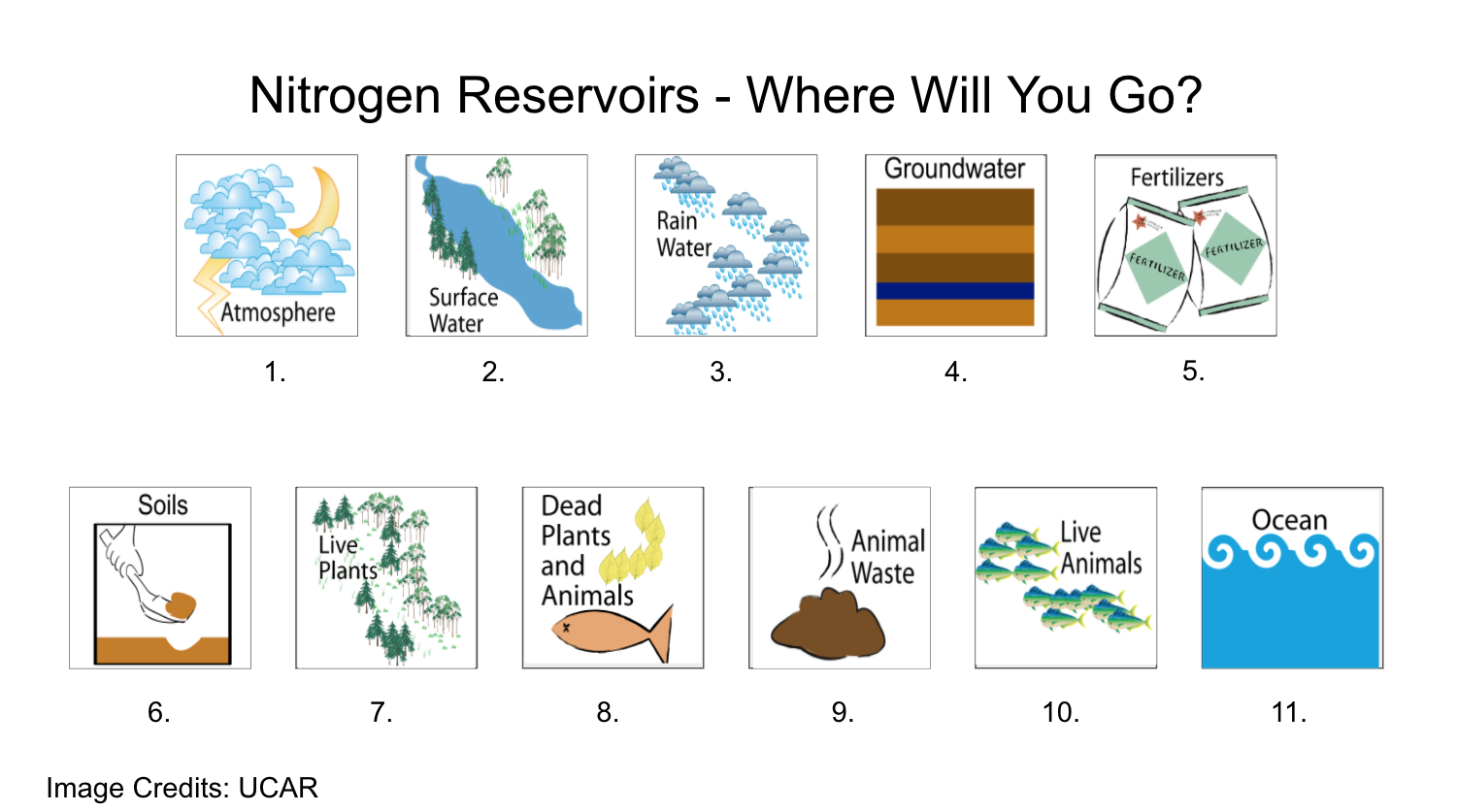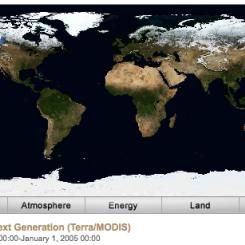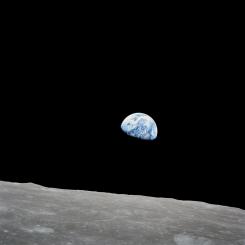Interactive Models
The Nitrogen Cycle Game
Overview
Students will explore the Nitrogen Cycle by modeling the movement of a nitrogen atom as it passes through the cycle. Students will stop in the different reservoirs along the way, answering questions about the processes that brought them to the different reservoirs.
This lesson was based on an activity from UCAR Center for Science Education.
Materials Required
- Google Slides: Nitrogen Cycle Game
- Google Forms: The Nitrogen Cycle Game student response form
- Access to internet
- Computer, tablet, or other device
- Earth System Graphic Organizer (optional)
Directions
- Discuss nitrogen with your class. Where is nitrogen found on Earth? Why is it important? What are some processes that help move nitrogen through the cycle?
- Show The Nitrogen Cycle video.
- Begin by looking at the slide showing the different reservoirs. What are some reservoirs that surprise your students?

- Explain the Google Slide for the Nitrogen Cycle Game & read the overview.
- Explain to students that by the end of the game they should be able to address the following questions:
- What are some of the processes that help move nitrogen through from one reservoir to another?
- What are some ways that humans can make an impact on the nitrogen cycle?
- Next, model for students how to click on the sphere icon to move between reservoirs throughout the game.
- Read the game instructions with the students. Students will model a nitrogen atom. They will roll a number cube to determine the trajectory the atom takes.
- Roll the number cube (or virtual die) to determine which center you will go to first.
- Locate this icon on the Nitrogen Reservoirs Slide and click on the hyperlink. This will take users to the first of two sequential slides that provide information that they will document in their response sheet (Form or other).
- Proceed to the next slide and click on the nitrogen reservoir that corresponds with the number you rolled and complete the instructions on the slide.
- It is important to record the process that brings you to the different reservoirs.
- Click the “where to go” button to transport you to the next slide.
- Roll the dice again and click the button that corresponds with the number you rolled.
- Review the Google Form (or worksheet) where students document their nitrogen journey.
- Proceed to play. After at least five-10 rounds, pull the class together to review their journey.
- Have students share their journeys.
- Review the processes involved with moving nitrogen in the cycle.
- Fixation: converts nitrogen in the air to ammonium, biologically available
- Nitrification: bacteria change ammonium to nitrates to be absorbed by plants
- Assimilation: plants absorb nitrates by the roots
- Ammonification: decomposers change nitrogen into ammonium to re-enter the cycle
- Denitrification: nitrogen in the soil gets back into the air
- Wrap up with a discussion that addresses the following points:
- What are some of the processes that help move nitrogen through from one reservoir to another?
- What are some ways that humans can make an impact on the nitrogen cycle?
- How similar or different are the different journeys that the students made?
- How long could the nitrogen cycle journey continue?
Assessment
- Students will fill out the Google Form.
- Consider having students complete the Earth System Graphic Organizer to document the sphere interactions.
Teacher Note
Most of the nitrogen on Earth is in the atmosphere. Approximately 80% of the molecules in Earth’s atmosphere are made of two nitrogen atoms bonded together (N2). All plants and animals need nitrogen to make amino acids, proteins and DNA, but the nitrogen in the atmosphere is not in a form that they can use. Atmospheric nitrogen must undergo a process called nitrogen fixation to be usable by living things. This can happen when molecules are torn apart by lightning or fire, by nitrogen fixing bacteria, or by bacteria from legumes. Other plants get the nitrogen they need from the soils or water in which they live mostly in the form of inorganic nitrate (NO3- ). Nitrogen is a limiting factor for plant growth. Animals get the nitrogen they need by consuming plants or other animals that contain organic molecules composed partially of nitrogen. When organisms die, their bodies decompose bringing the nitrogen into soil on land or into the oceans. As dead plants and animals decompose, nitrogen is converted into inorganic forms such as ammonium salts (NH4+ ) by a process called mineralization. The ammonium salts are absorbed onto clay in the soil and then chemically altered by bacteria into nitrite (NO2- ) and then nitrate (NO3- ). Nitrate is the form commonly used by plants. It is easily dissolved in water and leached from the soil system. Dissolved nitrate can be returned to the atmosphere by certain bacteria in a process called denitrification.
Certain actions of humans are causing changes to the nitrogen cycle and the amount of nitrogen that is stored in reservoirs. The use of nitrogen-rich fertilizers can cause nutrient leading in nearby waterways as nitrates from the fertilizer wash into streams and ponds. The increased nitrate levels cause plants to grow rapidly until they use up the nitrate supply and die. When the plant supply increases, so do the number of herbivores. However, when the plant supply dies off, there is increased resource competition in the herbivore population. In this way, changes in nutrient supply will affect the entire food chain. Additionally, humans are altering the nitrogen cycle by burning fossil fuels and forests, releasing various solid forms of nitrogen. Farming also affects the nitrogen cycle. The waste associated with livestock farming releases a large amount of nitrogen into soil and water. In the same way, sewage waste adds nitrogen to soils and water.
Sources:
- The Nitrogen Cycle Game | Center for Science Education. (n.d.). UCAR Center for Science Education. Retrieved April 14, 2023, from https://scied.ucar.edu/activity/nitrogen-cycle-game
- Krebs, E., Delac, J., & Smat, R. (2016, May 10). The Nitrogen Cycle. YouTube. Retrieved April 14, 2023, from https://www.youtube.com/watch?v=PfqvACMyg68
Teachers who are interested in receiving the answer key, please complete the Teacher Key Request and Verification Form. We verify that requestors are teachers prior to sending access to the answer keys as we’ve had many students try to pass as teachers to gain access.
- Students will understand how nitrogen moves between reservoirs and is constantly recycled.
- Students will be able to identify nitrogen reservoirs.
- Students will understand the importance of nitrogen as it relates to Earth as a system and as it relates to you personally.
- Students will understand that nitrogen travels freely between physical aspects of Earth and living things.
- What parts of Earth need nitrogen?
- What are some of the processes that help move nitrogen through from one reservoir to another?
- What are some ways that humans can make an impact on the nitrogen cycle?
- Internet Required
- One-to-One (tablet, laptop, or CPU)
- One-to-a-Group




